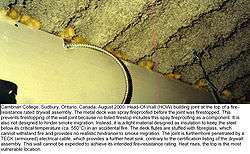Penetrant (mechanical, electrical, or structural)

Penetrants, or penetrating items, are the mechanical, electrical or structural items that pass through an opening in a wall or floor, such as pipes, electrical conduits, ducting, cables and cable trays, or structural steel beams and columns. When these items pierce a wall or floor assembly, they create a space between the penetrant and the surrounding structure, which can become an avenue for the spread of fire between rooms or floors. Modern building codes generally require a service penetration firestop to seal the openings around penetrants (or "services"), in order to restore the fire-resistance rating of the parent assembly.
Sizing of all openings has significant impact upon the adherence to the certification listing requirements. Therefore, communication between all affected trades is of great importance before any openings are made, to ensure proper sizing of the openings for cost control and conformance with listing and approval use and compliance.
Penetrants are typically accommodated by plumbers and electricians, who prepare for them by installing sleeves in concrete walls and floors, before they are poured. In the case of masonry walls, electricians and plumbers tend to be there first and hang sleeves around their piping, ductwork and conduit, where they know from their drawings that block walls will be erected, in order to avoid the time and expense of having to cut openings in existing walls and floors.
In the case of drywall assemblies, the opening size is determined by the drywall contractor, unless the mechanical and electrical trades are contractually obliged to provide sleeving here as well, with proper fastening methods that are in conformance with the certification listing. It is not uncommon for these trades to attempt to absolve themselves of the requirement to firestop their openings in the drywall assemblies by claiming that they were there first, meaning that others should take care of the rest. Since drywall contractors are not ordinarily required to do mechanical and electrical firestopping, the drywall openings can become an item of dispute or neglect, particularly in North American construction. This common issue can be minimised by designating a separate firestopping sub-contract, whereby a separate speciality sub-contractor firestops all openings on site, mechanical, electrical and structural, as well as the building joints.
Timber floor openings are simply cut by means of a chainsaw. In this case, the width of the blade will determine sizes.
-

Electrical cable through-penetration, firestopped by an intumescent sealant, to restore the two-hour fire-resistance rating of the concrete floor.
-

Steel beam through-penetration. The firestop surrounding the beam is incomplete - packing only, sealant is yet to be applied. The beam itself must be treated with fireproofing to prevent it from twisting and damaging the wall during a fire.
-

Sprinkler branch pipe through-penetration with plastic sleeve - missing firestop in concrete fire separation. The branch pipe is a penetrant, as is the plastic sleeve, which is a code violation if left in place, unless it is in conformance with a firestop certification listing that permits such sleeving.
-

Cable tray cross barrier firestop test, full scale wall, in Germany as per DIN4102.
- Examples of common firestop/penetrant problems
-

A typical fire problem—the measures taken by the plumbers and the drywallers are at cross-purposes.
-

Penetrants have been punched and burned through drywall, compromising its integrity.
-

Mechanical shaft with compromised fire-resistance rating through pipe installation.
-

Finished, painted, fire-resistance rated drywall assembly. A common deficiency: Lift ceiling tiles and find electrical and mechanical service penetrations without a firestop.
-

Improper drywall and absent firestops
-

Improper firestop and fireproofing interface, August 2000
-

Improper breach of fire-resistance rated drywall assembly, August 2000
-

The "I-was-there-first" scenario, resulting in improper drywall firestops with plastic piping.
